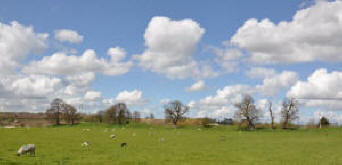|
|
|
|
Caistor St Edmund
|
Caistor St Edmund lies approximately four miles south of
Norwich. It is a small village today but was once the
location of Venta Icenorum - one of the the largest Roman
settlements in East Anglia.
|

Venta Icenorum
|
The site, which has been excavated on a number of
occasions, once contained temples, baths, a forum and an
ampitheatre. Aerial photographs taken by the RAF in 1928
first revealed the extensive street pattern under the soil
and in the following year an archaeologist from Manchester
University named Donald Atkinson began to unearth the
secrets of the site.
Ninety years later a second
excavation was undertaken by Professor Will Bowden from
Nottingham Univeristy and a large team of volunteers. They
worked for 10 years and the excavation finally ended in
2012. Their evidence suggested that the town was much larger
than was originally thought.
Inside the south-east
corner of the walled town lies St Edmund's Church.
The tiny River Tas flows past
the walls of the Roman Camp. Originally it was thought that
the Tas was much larger during Roman times and that barges
unloaded commodities here - but recent research suggests
that it was probably the same size that it is today - though
its channel may have shifted.
Today the site is used
to graze sheep but is easily accessible and there are
noticeboards providing information about the town and its
history.
There is a sonnet about Venta Icenorum by
the Norwich poet Ron Nevett.
|
On Caistor St Edmund
Caistor
was a city when Norwich was none,
Norwich was built of
Caistor stone
(Anon)
On wildflower walls a
fading legionary
Observes the Norwich-London train's
straight line
Unseen by sheep who chew the greenery
Inside their quadrant's crumbling flint and lime
One
year the barley glowed with road and alley
And showed the
airman Venta Icenorum
Was not an idle story of the valley
But clay and timber: temple, baths and forum
And
citizens, like Nase who scratched a lead scroll
To offer
Neptune leggings for a thief
Or those who gamed with
bones or broke a red bowl
Or wore the sunlight on them as
gold leaf
And heard an empire passing with a shiver
And turned to grass and earth beside Tas river
|
I have also written a villanelle about the Roman
Camp.
|
Venta Icenorum
Under this field, the old street patterns lie
But all the legions have now marched away
And cawing rooks
above the treetops fly
Beneath an ever changing
Norfolk sky
And only crumbling walls remain today
Under this field, the old street patterns lie
And the
London train passes by on high
And only grazing sheep are
here to stay
And the tiny Tas runs quietly by
No
vendors in the busy market cry
No worshippers to Mars and
Venus pray
Under this field, the old street patterns lie
No boats upon the river now untie
No actors in the
ampitheatre play
And the tiny Tas runs quietly by
For in the end, all empires fall and die
And time moves
forwards without delay
Under this field, the old street
patterns lie
And the tiny Tas runs quietly by.
|
Links:
More photographs of Caistor St Edmund |
|
|
|

